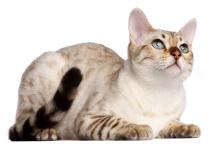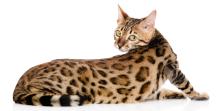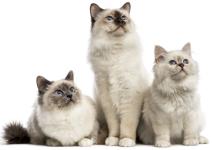Find Tests
The AB system is the major blood group system in domestic cats. The common blood types are A and B, ...
The agouti signaling protein interacts with the melanocortin 1 receptor to switch between black and ...
The feline albino mutation is a rare mutation that produces a white coat with blue eyes, and is rece...
In Norwegian Forest Cats, a recessive mutation in the melanocortin 1 receptor gene leads to the grad...
Cats with brown gene variants have reduced amounts of black pigment and appear brownish in color.
Burmese head defect (BHD), or congenital frontonasal dysplasia, is an inherited defect found in Burm...
Burmese hypokalemia is an inherited disorder found in Burmese cats that is characterized by skeletal...
Burmese russet coat color is a coat color that develops with age and is characterized by progressive...
Charcoal Bengals sport an unusual coat marking of a darker face mask and dark thick dorsal stripe ("...
Cats with colored 'points' have genetic mutations associated with temperature-sensitive pigment prod...
Cornish Rex cats have short, soft, curly coats inherited in an autosomal recessive fashion. This tra...
Dilute is an autosomal recessive trait that causes clumping and uneven distribution of pigment granu...
The dominant white and white spotting mutations cause white patterning in cats.
Erythrocyte pyruvate kinase deficiency (PK deficiency) is an inherited hemolytic anemia caused by in...
Birman cats have clearly defined white feet ("gloves") as part of their breed standard. This charact...
GSD IV leads to progressive organ dysfunction, generalized muscle atrophy, and eventual death in aff...
GM2 gangliosidosis is a degenerative, fatal neurological disease characterized by severe muscle trem...
Cats affected by hypertrophic cardiomyopathy are at risk of sudden cardiac death. In Maine Coons, a ...
Cats affected by hypertrophic cardiomyopathy (HCM) are at risk of sudden cardiac death. In Ragdoll c...
Korat GM1 gangliosidosis causes progressive neurologic dysfunction and premature death in Korat cats...
Korat GM2 gangliosidosis causes progressive neurologic dysfunction and premature death in Korat cats...
Four mutations that produce long-haired coats in domestic cats have been identified in a single gene...
Mucopolysaccharidosis VI is an inherited lysosomal storage disease that has mild and severe forms. S...
This DNA-based parentage test uses microsatellite marker analysis to compare the DNA profile of an o...
Feline polycystic kidney disease (PKD1) is a heritable form of polycystic kidney disease commonly se...
This progressive retinal atrophy is an inherited late-onset blindness condition seen in Abyssinian, ...
This progressive retinal atrophy is an inherited, rare form of early-onset blindness seen in Abyssin...
Progressive retinal atrophy (PRA) causes an autosomal recessive blindness in Bengal cats by destroyi...
A recessive, inherited form of progressive retinal atrophy in Persian cats leads to retinal thinning...
The Scottish Fold breed produces cats with both straight and folded ears. A single copy of the fold ...
The Selkirk Rex breed has curled hair that can be short or long. A single copy of the variant that c...
The Devon Rex breed produces a curly coat and the Sphynx breed is nearly hairless. The nearly hairle...
Congenital myasthenic syndrome causes a congenital muscle weakness in Devon Rex and Sphynx cats.
Spinal muscular atrophy (SMA) is characterized by progressive instability with unsteady gait and pos...







